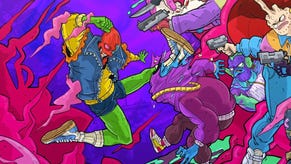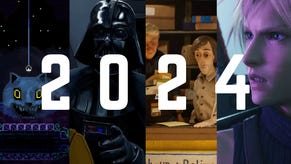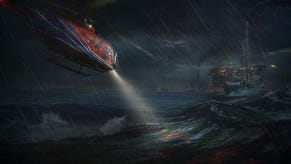Still Wakes the Deep mixes perfect horror timing with an environment that was already terrifying
The Chinese Room returns with the world's most atmospheric oil rig.
Look behind you. I don't want to! You must. You must! In Still Wakes the Deep, a horror game set on an oil rig, there is a button you can press that allows you to look behind you. They don't tell you this at first. They don't tell you this when you're learning how navigation prompts work or how to crouch. They wait for about an hour - it feels like about an hour - until everything on the rig has started to go wrong, until you're deep in the machine somewhere, knee-high in freezing black water, squeezing through the very tightest of mechanical spaces. Then they teach you.
Personally, I have never been less pleased to discover a new in-game power. The lights flicker. The water churns. The entire rig squeaks and groans - this incessant resettling of metal and cabling is real, by the way; the team picked it up from a documentary. And then the prompt: hey, you can look behind you if you press this button. But why would I want to do that? Why would I need to do that? Take that button away!
"We got you!" says Rob McLachlan over Skype when we're discussing my play session later on. McLachlan is the lead designer of Still Wakes the Deep at The Chinese Room. Neat, precise, and polite, there's clearly a splinter of anarchy in McLachlan somewhere - as there should be. "That's exactly what we wanted," he tells me of my reaction to the button prompt. "We were thinking: where can we teach the player to do this? So if you're in the middle of something stressful, that would be a really bad time to teach this." He pauses, still delighted. "I'm really glad that worked for you."
Timing. The more I think back on my two hours with Still Wakes the Deep - a game whose looming, shadow-hulk name will not untangle itself in my brain; I keep calling it What Lies Beneath - the more I think it's all about timing. I reckon I've played about the first third or the first quarter of the game and more than anything I'm left with this memory of being in the middle of a design that feels like a dialogue - a dialogue between my expectations as someone who knows they're playing a horror game, and designers who know that I know and want to trip me up even more despite all that.
For starters. I don't know if you've seen the movie Cloverfield, but Cloverfield does something completely brilliant in its first act. Everyone who's gone to see it is aware that it's a movie about a monster attacking New York, so when it starts and people in the film are getting ready for a party, you're sitting there in the dark, just wondering: will the monster attack now? Maybe now? How are they going to do it? How are they going to stage it?
So what Cloverfield does is extend this opening as long as possible, and make it really soapy, fill it with domestic plot-lines and squabbles and characters who are annoyed at each other. You're waiting for the monster, and you're aware that the movie knows you're waiting and is going to try and distract you, but then all this other stuff happens and it's so human and silly that you genuinely do get distracted. And then the monster attacks. (Sorry for spoiling Cloverfield.)
Still Wakes the Deep plays its own version of this, a version that's different in one distinct way. But yes, first, it takes its time. You're a Scottish guy called Caz working on an oil rig in the 1970s. You're in trouble for something you've done, and it's caused ripples that are messing with your home life and putting your job on the rig in jeopardy. The boss wants to see you in his office. Your friend, the cook, wants to see you in the canteen. Hey, your friend mentions he needs someone to pick up his insulin, so he's diabetic? It's Christmas, looks like there's haggis for Christmas dinner. But the boss is getting impatient to see you and probably fire you, and people are working and stressed because the drill's hit something or other... And...

Okay, classic Cloverfield delaying tactics. But there's more, and this is a trick that only Still Wakes the Deep can play. All this domestic stuff - moving around the rig, talking to people, getting a sense of the place? Even pre-disaster, this stuff is already terrifying. Because you're on an oil rig. And oil rigs are terrifying places.
I mention this to John McCormack, studio art director at The Chinese Room and the project creative director on Still Wakes the Deep. (I remember him from doing a lot of the art for the Fable games.) I wonder: does setting a horror story in a place that's already so frightening mean that the team has to raise its own game to compete with the environment as is? "That's one instinct," says McCormack politely. "But I think another is just exposing the horror of the rig itself." I tell McCormack that there were times when I was playing, where I was definitely as scared of just being in the rig as I was of the supernatural stuff. "That's what we want," he says. "The rig and the water. If you were in an earthquake, that's terrifying, but if you're on a precarious platform during an earthquake? That's the thing.
"If you were on an oil rig, the fact that there's something on board ripping it apart?" He laughs. "It's the fact that you're on this rip-apartable thing suspended above freezing death temperatures. The two things should coincide." So the horror, in RPG terms, should stack? "In early designs we were really explicit," says McCormack, nodding. "You should be terrified all the time. Being in the water's terrifying. Being out of the water's terrifying. Being up high. Being near electricity. We sort of listed all these phobias. How can an oil rig exploit vertigo? Claustrophobia? Fear of drowning? We just listed them and said: yep, an oil rig can do all of these things. And then the supernatural stuff takes a load of other ones."
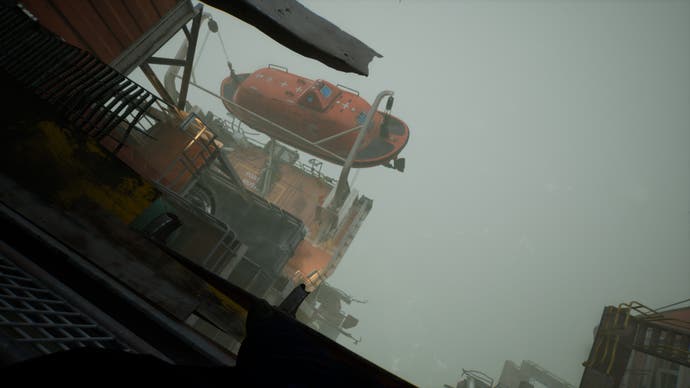

It's an enviable position for a horror game to be in, but it brought its problems. Over time, the team realised they needed moments to calm you and ground you for a few seconds. And that's hard on an oil rig. Particularly this one: lashing winter, the grim 1970s. Even the Christmas trees scattered around the place look slightly uncanny.
The result is a game where even the calmest moments are slightly odd, slightly precarious. Pre-disaster, just getting from A to B is tricky, for example. On an oil rig, cramped and elbowy and yet somehow completely gigantic too, there are no straight lines. When Caz sets off to the boss's office he finds himself outside with the office in front of him, but to get there? Gantries, a bit of mantling, moving under, around, through.
"One of our challenges was to make the rig a place that supported the story," McLachlan explains. "There's a sense of foreboding and complication to how we move you through the environment from the start. That feeling at the start of a movie where things feel a bit off, where you feel like you're in a place that's not quite belonging to you? It's our desire to balance that with our desire as game makers, which is to guide the player through the game in a way that's intelligible to them. This was a thing we were constantly fighting - those two different impulses."
The oil rig setting is so evocative - teetering shipping containers, some of them repurposed as office space, the endless gantries, the clanging gates and fences. It's a greasy, rusting, creaking working space, albeit one that exists over the endless churn and thrash of sullen grey waves. How realistic is all this? Did the team do a lot of research into rigs in general?

Yes, basically. Alongside watching films and documentaries and looking at books, the team interviewed a friend of a friend who was Scottish and had worked on rigs in the '70s. Bullseye.
Beyond that? "We did a lot of research on things that went wrong on rigs," says Laura Dodds, the associate art director. She trails off slightly at the thought. "It actually blows my mind that these things function at all, that anyone conceived of these things and put them together."
I never get entirely used to the rig, by which I mean that it's always a thrill just to move around, to head over to the boss's office and get an authentic Scottish bollocking, and then head off again, up, down, through: gantry, walkway, shake and squeak.
And then things go wrong. Brilliantly, Still Wakes the Deep keeps you in first-person and denies you any kind of overview. When the disaster occurs you're not sure what kind of disaster it is, or whether it's actually a disaster at all.
But it transforms the rig. Soon pieces are falling off, tumbling into the waves, and the first post-disaster mission involves finding a new path to an old location, this time in a muddle of walkways suspended under the rig, many of which have fallen away.
The sea is the star in this sequence, raging beneath you, adding extra panic to each jump and clutch. This is still the Chinese Room, and you could just about argue this is a "walking simulator". But at times it's a walking simulator like the early Tomb Raider games were - you mantle a lot, grip onto this ladder, shimmy across this spar of steel.
And so the next hour or so sees The Chinese Room building on all the work it's done establishing this place so carefully. Back inside doors are barricaded, friends and colleagues are suspicious and frightened. Old paths cannot be used and new paths are hard to find. Interacting with the rig itself is always a chunky, tactile delight, though: doors have wheels you spin to open them. Ladders have a little handle on the side to drop them. Grates must be unscrewed and then pried off the wall. Deeper I go, into the dark, into the maze between water tanks where the lights go out and where I'm suddenly told I can look behind me if I need to. But why would I need to? Then a laundry room where I'm hunted by something terrible and largely unseen, sneaking and crawling, ducking in and out of lockers. It's standard horror stuff, maybe, but it's elevated by the brilliant setting and by this almost psychic connection the designers seem to have with what I'm thinking, how I guess things will turn out. They seem to know what I'm anticipating so they can frustrate my expectations.
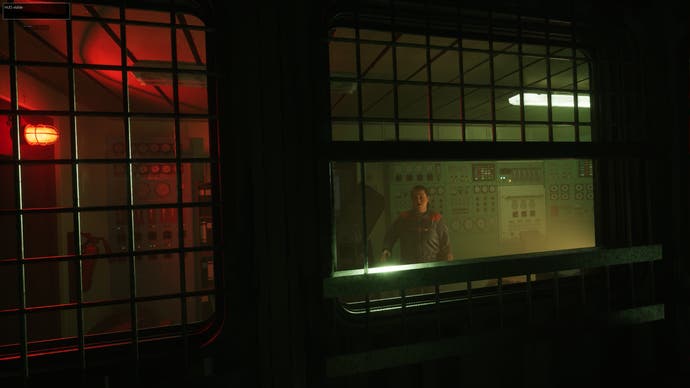
More than anything, this is what I'm curious about. Still Wakes the Deep is a game of carefully placed surfaces, a game of precision viewpoints and millisecond staging. As I've said, it feels like the designers and the player are engaged in a dialogue in real time. How do you pull this sort of thing together?
Iteration and playtesting, apparently. "Before you get close to making a game right you make it wrong first," says McCormack. "We were very good at that," laughs McLachlan. "I don't think I've ever worked on anything in thirty years that has been successful where what was on the paper ended up anything like the game," McCormack continues. "It really is just a loose blueprint. You need to experiment early."
"We condense it too," says Dodds. "It's quality care and density and curating the experience. When people say that things feel like they happened at the right time, it's because we orchestrated moments, which is totally cross-disciplinary."
That cross-disciplinary line is the moment it all clicks for me, actually. There are scares here, clever set-pieces, and an enviable forward momentum that is somehow enhanced by the clutter and tangled interiors of the rig. But it's the cross-disciplinary design, the way art and sound and level creation and dozens of other things I'm too thick to recognise come into play that make it so special.
And beyond that I think the cross-disciplinary approach has extended to a certain willingness to take ideas from anywhere and anything. Still Wakes the Deep has definitely seen the classic horror movies of the '70s and '80s, but it's also pondered the best kind of glass to put in window frames to unsettle you (it's the ribbed kind), and it's worked out that washing machines can be a bit creepy if they appear in the half-dark, metal glinting, but that open drum completely black, like the eye of a cyclops. It knows that an oil rig emerging from a grainy Scottish haar will make players think of a cathedral, something godly and inhuman and too big and too intricate. It knows that the Shipping Forecast, deployed at just the right moment, will be completely unsettling. The Shipping Forecast!
In games, in art, there is a rich pleasure in being deeply, utterly manipulated like this. Go here, do that, look behind you! Boo! This stuff works. But it works even better when you're somewhere new and unexplored, when it's all delivered with a combination of observation and imagination. The disciplined eye and the wild mind, as the poet said. True for Cloverfield, true for this.





